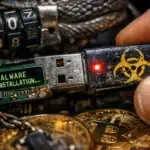Security researchers at Positive Technologies have uncovered a sophisticated cyber espionage campaign conducted by the threat actor known as PhaseShifters (also tracked as Sticky Werewolf). The group has been implementing advanced steganography techniques to conceal malicious code within seemingly innocent image and text files, effectively bypassing conventional security measures.
Sophisticated Target Selection and Attack Methodology
The PhaseShifters group demonstrates a clear focus on Eastern European targets, primarily directing their efforts toward government institutions, industrial facilities, and research centers. Their primary attack vector involves highly targeted spear-phishing campaigns, where attackers masquerade as legitimate officials requesting document reviews and signatures.
Technical Analysis of the Malware Campaign
The attack chain involves multiple sophisticated malware variants, including Rhadamanthys, DarkTrack RAT, and Meta Stealer. The infection process begins with password-protected archives containing malicious files, which, when opened, trigger scripts that download steganography-encoded payloads hidden within image files. This innovative approach significantly reduces detection rates by traditional security solutions.
Advanced Steganography Implementation
The threat actors employ state-of-the-art steganography techniques to embed malicious code within image files, making the malware practically invisible to conventional scanning tools. This method represents a significant evolution in malware delivery mechanisms, demonstrating the group’s technical sophistication.
Threat Actor Attribution and Connections
Analysis reveals significant operational overlaps between PhaseShifters and other prominent threat groups, particularly TA558 and UAC-0050. The shared use of specific steganography techniques, identical obfuscators, and crypters obtained from darknet markets suggests possible collaboration or knowledge sharing between these groups.
Technical Indicators and Infrastructure
Forensic analysis has identified common patterns across the groups’ activities, including identical PowerShell script structures, similar variable naming conventions, and matching payload storage methods. These technical similarities strongly suggest that PhaseShifters and UAC-0050 may be the same entity operating under different names.
The emergence of these sophisticated steganography-based attacks represents a significant evolution in cyber threat tactics. Organizations, particularly those in Eastern Europe, should implement advanced security measures including behavioral analysis tools, enhanced email filtering systems, and regular security awareness training focusing on sophisticated phishing techniques. Continuous monitoring and threat intelligence sharing remain crucial for detecting and preventing these evolving threats.






